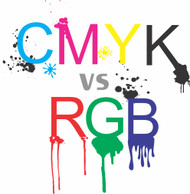CMYK vs RGB - what are they and why are they important
Posted by Karen Gendron on 25th Sep 2018
CMYK vs. RGB
CMYK and RGB are different ways that screens and printers produce colour. CMYK stands for Cyan, Magenta, Yellow and Black. RGB stands for Red, Green and Black. Using more colours allows one to create a greater range of printed colours.

Due to cost, RGB is typically used in electronics. Most computer screens, TV’s and phones have RGB screens. Therefore, when a designer is saving something for the web it is normally saved in RGB. A cheaper desk top printer is usually RGB as it helps to keep ink costs down. Sadly, it does not give the greatest colour quality.
Most large format printers use CMYK. This becomes an issue when a designer is creating artwork on an RGB screen and then expects it to be exactly the same when printed on a CMYK printer. Most of the time the difference is imperceptible, but there are certain colours that do not translate well.

Colour translation from RGB to CMYK depends on the printer itself. At Stickernut we use a printer that prints with CMYK Light Magenta and Light Cyan, in addition to CMYK. This allows us to not only better match colours, but make them richer with truer skin tones.

Do we colour match at Stickernut?
We try our best to colour match, but it is not a guarantee. The only way to attempt a close colour match is by having a physical sample of the colour that you are looking for. The universal colour match system we use is called Pantone Matching System (PMS).
What is Pantone or PMS?
Pantone is a company that is known for its Pantone Matching System (PMS). PMS is a standardized colour reproduction system. By standardizing the colours, different manufacturers in different locations can all refer to the Pantone system to make sure colours match without direct contact with one another. The problem with PMS? Many CMYK colours cannot be matched in PMS. This is another reason why we cannot guarantee colour matches.
Since RGB and CMYK are both device-dependent, there is no simple or general conversion formula that converts between them. Conversions are generally done through colour systems, using colour profiles that describe the spaces being converted. The conversions cannot be exact.
Shades of Black?

There are shades of black when printing in CMYK. (There are shades of grey too, but let’s concentrate on the colours rather than whips!)
C:0 M:0 Y:0 K:100 is very different from C:100 M:100 Y:100 K:100 as shown in the illustration. When not placed side by side, you most likely would not notice the difference, however you certainly can see the difference when placed one on top of the other.

Colour and Light Reflection
The human eye is made of up rod and cone photoreceptors: rods responsible for low light vision, and cones capable of colour vision. The colour that you see depends on the light frequencies that the object absorbs, as well as the frequencies in the original light source. The figure on this page shows how this works with reflected light. If a surface doesn’t absorb any colours, then all the colours are reflected, and you see white. If the surface absorbs all red and only red, then it reflects green and blue, so you see cyan, and so on.
Matte and Glossy - What's the difference?
At Stickernut, you have your choice of matte or glossy vinyl. Matte vinyl vs glossy vinyl on a microscopic level have differences that make them either matte or glossy. Matte would have a lot of hills and valleys, whereas gloss is flat. Both cause light to disperse differently because of that effect. In addition, the colours may look different, despite printing the exact same file.

Picture above demonstrates glossy (top) and matte (bottom) reflecting the same light.
In a nutshell, colour is complicated. Keep this in mind when ordering your Stickernut stickers!

